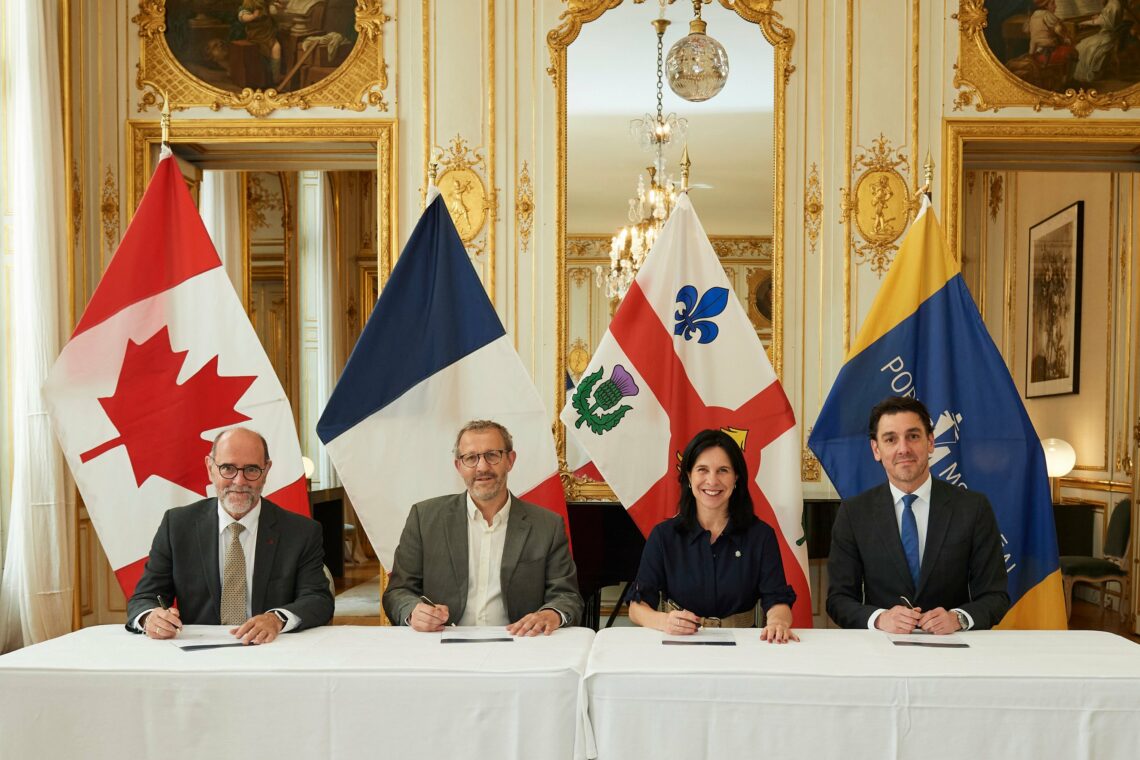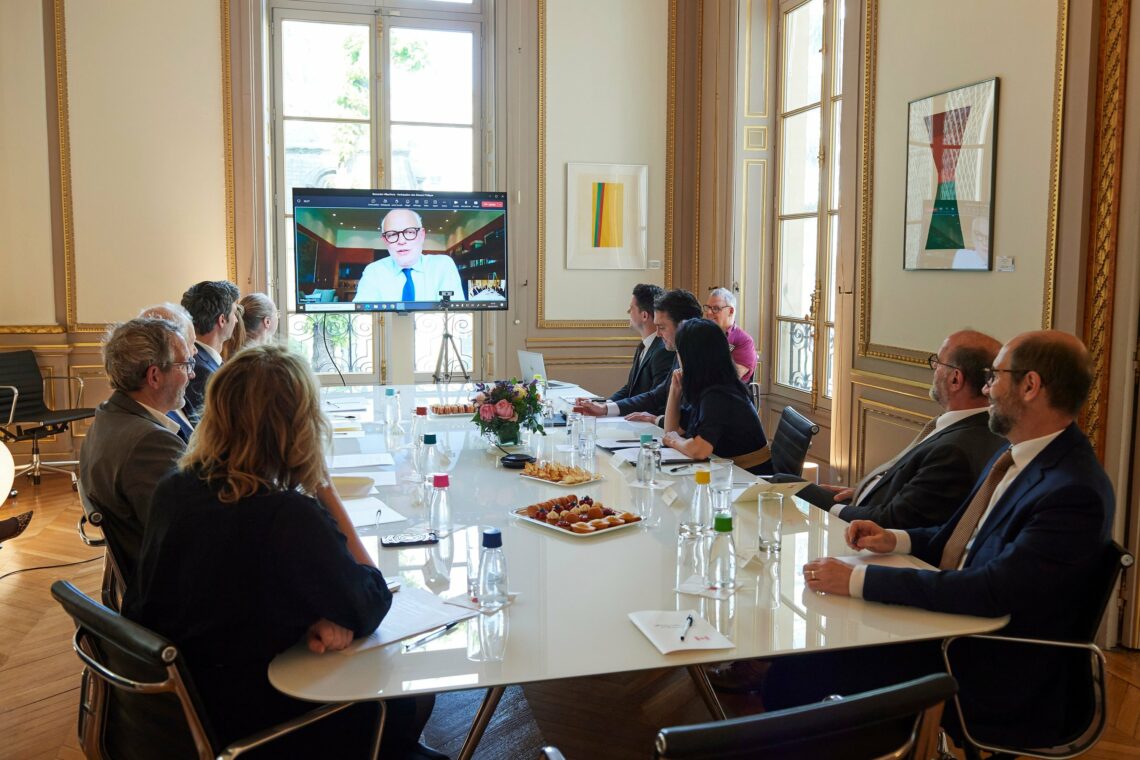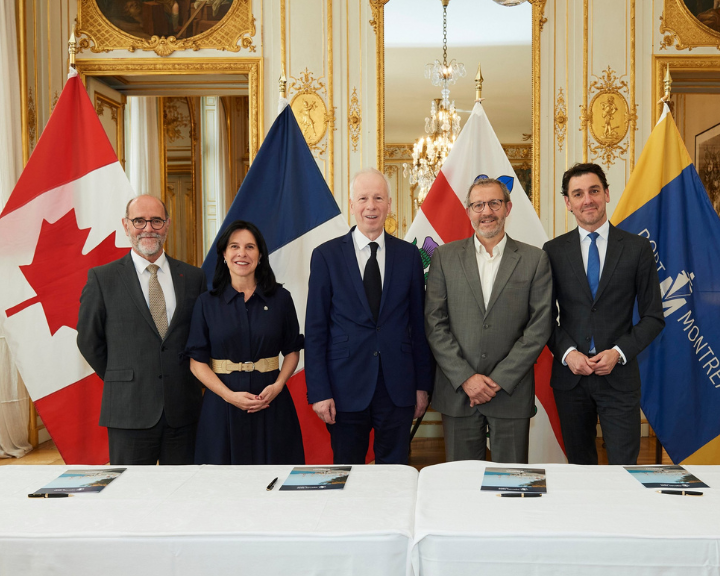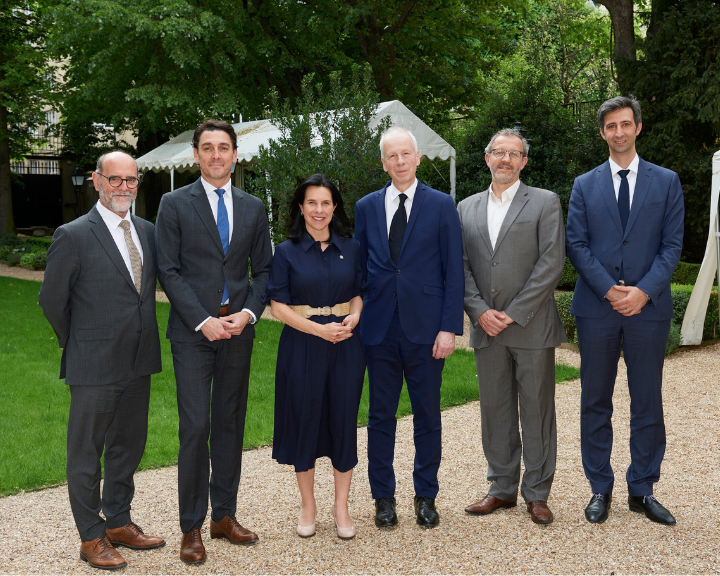Montreal in Quebec is one of the biggest port cities not just in North America, but in the French-speaking world. With its ocean port on the majestic Saint Lawrence river, relations between the City of Montreal and the local Port Authority are more promising than ever. Representatives from the two Canadian institutions were in Paris recently, to sign up to AIVP’s 2030 Agenda. They undertake to pursue the United Nations’ Sustainable Development Goals together, in their respective roles as port city and port authority.
Through the liaison committee set up and regular dialogue between their staff, the two bodies are already working in tandem in a number of areas, ranging from the city-port interface zone, to biodiversity conservation, promoting maritime culture, coexistence with neighbouring communities, and climate change adaptation.
Ms Valérie Plante, Mayor of Montreal, and Mr Martin Imbleau, CEO of APM Port de Montréal, have been talking to us about their shared City Port ambitions.
The City and Port Authority of Montreal have been members of AIVP since 2022 and 1993 respectively.

©André Cathy
A joint vision for the future
AIVP – Ports and cities all over the world are setting out their visions for the future. This will be one of the key themes at AIVP’s conference in Venice, in November 2023. The City and Port of Montreal both have strategic visions for 2030. Can you tell us about them, and outline some of the joint strategies you have adopted to make them a reality?
Mr Imbleau – In several respects, there are areas of convergence and similarity between our two strategic plans, and that makes matters much more straightforward between our organisations. Particularly when it comes to relations with the public, climate change adaptation, and cutting greenhouse gas emissions. That’s no accident. Because the Port’s strategic plan is the result of a wide-ranging consultation, in which large numbers of Montrealers took part. This plan is their plan, because the Port of Montreal is their port!
Ms Plante – Montreal has a strong culture of public participation, including through the citizen participation and public consultation mechanisms introduced by us, which have inspired numerous organisations, like the Port. So the Montreal 2030 plan, which is the framework that will guide what we do this decade, was built together with the people of Montreal. It’s easy to imagine a carbon-free future in a great city with human-sized districts like Montreal, because that’s what Montrealers want. And of course, that also poses questions for the relationship between the City and the Port, particularly when it comes to local development, because if the Port fails to take into account the views of its neighbours, it will be increasingly difficult to have a positive social impact.

A productive collaboration for a sustainable port-city
AIVP – How important do you think cooperation is for creating a sustainable and viable port city by 2030?
Ms Plante – Collaboration really is part of Montreal’s DNA. If we have a reputation as a creative city, that’s partly because everyone works together. Of course, the City’s teams are working more and more closely with their counterparts at the Port to find solutions to current and future challenges. Fighting and adapting to climate change, protecting biodiversity, developing a fair and just city, that’s everybody’s business. Montreal is committed to achieving those objectives, but I know we can’t do it alone. That’s why our collaborations, including with the Port, are so crucial. It’s also worth bearing in mind that Montreal is the gateway to North America, especially for Europeans. That positioning is strategically important for our city’s economy, and it is made possible by the strong links between the City of Montreal and the Port. And as you know, by working together on major issues, you also develop all kinds of other productive collaborations.
Mr Imbleau – As the saying goes: “Alone, you go faster. Together, you go further.” So when it comes to collaborations, our doors are always wide open. I often tell the teams that you have to be open to influence, but you also have to influence others. The plans to improve the city-port interface that we will be developing between now and 2030 will be better as a result of that dialogue, which has been hugely beneficial for us. Whether it’s developing buffer zones or observation points to restore views of the river. You can’t do all that in a vacuum!
Open dialogue is key to a renewed governance
AIVP- Renewed City Port governance, which is Goal 4 of the AIVP 2030 Agenda, will also be central to our discussions at the Venice Conference. Can you tell us how citizens and stakeholders in Montreal are involved in building your 2030 Vision?
Mr Imbleau – In terms of governance, we have learned a lot in recent years. We have set up a neighbourhood committee, begun broad discussions with our strategic plan, and significantly increased the scope for dialogue with our neighbours when developing projects. But we still need to go further, because we don’t just want to be tolerated, we want to be admired. We want the Port of Montreal to be a symbol of pride, and we can’t do that without dialogue with the people who are our neighbours. That represents one of the Port of Montreal’s values.
Ms Plante – There is lots happening in Montreal and many parts of the local area that were once managed by the Port will soon be the focus of a new development vision. But when you’re developing an area so charged with history, you have a duty to do it in collaboration with the community. That means giving them more opportunities to make their voice heard, but doing so with a really open mind. That ongoing dialogue, and that willingness to listen to the experts and the public, is key to making quality projects. That takes time, but it’s necessary, as the decisions we take today to develop sectors near the port will have an influence for decades to come. So it’s important to do things in an exemplary way. We also want to make Montreal a city of reconciliation with the indigenous peoples. We work with all of the partners and pay tribute to the leadership shown by Port Montreal, which has joined the Grand Economic Circle of Indigenous Peoples and Quebec.
A coordinated effort to address the Agenda 2030
AIVP- The two organisations have worked together to look at what they are doing now and what they could potentially do, both individually and collectively, to achieve the various goals outlined in the AIVP 2030 Agenda. What is your verdict on that exercise, and would you recommend other ports and cities copy it?
Mr Imbleau – Putting our projects together and being transparent, as the City’s people and our own teams have done, comes with challenges. It showed us that, although we had different outlooks, and sometimes different priorities, we still shared many of the same goals. Those shared goals provide a solid foundation going forward, because our intention is not merely to stand by and watch each other’s projects. Our intention is to build more coordinated, concerted projects, in particularly for improving the interface between the city and the port.
Ms Plante – In many respects, the teams found that the port is almost like a city within the city. When we looked at what each of us was doing, we quickly realised that, from rainwater management to tree planting, there were a number of things we were already doing together. Thanks to AIVP’s remarks (and to the 2030 Agenda), we also saw that there were areas where we needed to collaborate more, such as coordinated planning of public and active transport networks and biodiversity protection. Montreal recently hosted the COP 15 biodiversity summit, and we are aiming to accelerate our efforts on this issue greatly. So why not do it together!
A high-quality Port-City interface for Montreal
AIVP- Goal 8 of our 2030 Agenda on the City Port interface is AIVP’s original raison d’être. What projects are the City and the Port working on, to develop and showcase this zone and open it up to the public?
Ms Plante – In Montreal, there’s no shortage of projects! When you look at a map, you quickly see that the areas around the port are set to benefit from development that is unique in Montreal’s modern history. So for us, improving the interface between the city and the port is essential. We are aiming to develop human-scale precincts that offer high quality of life all over the city, and the areas immediately around the port are no exception! On the one hand, the teams are working with developers to design homes that will be less exposed to noise and other disturbances that come with the port, due to the nature of its activities. The Port, meanwhile, is taking steps to ensure that the architects fully understand the operational realities involved. That is one of the AIVP recommendations we are treating as particularly important. Many cities around the world have successfully completed innovative development projects in the area around their port zone. By sharing our expertise, we can learn best practices.
Mr Imbleau – There’s no doubt that developing sectors like the old Molson brewery, just a few yards from our installations, represents quite a challenge. But we prepared for this major change. Our in-house teams, in consultation with the City, produced a comprehensive study of the city port interface and we have a holistic vision of that interface. The result is that we have been able to identify flagship projects, including a green belt that will eventually link up with the network of cycle paths in the city centre and ensure easier access to Jean-Drapeau Park. And we won’t stop there. We have just committed in our strategic plan to invest at least $10 million in projects of this kind, and we hope that every level of government will get on board.
Montreal’s priorities for 2025
AIVP- To conclude, in the short term, for the Port and City of Montreal, what are the three priority goals of the AIVP 2030 Agenda that you intend to focus on between now and 2025?
Ms Plante and Mr Imbleau – All of the goals are important, but some are a particular priority for Montreal. They include protecting biodiversity (10), the energy transition and circular economy (2), and the city-port interface (8).

©André Cathy
Photo credits: ©André Cathy
To find out more about the AIVP’s AGENDA 2030: here





